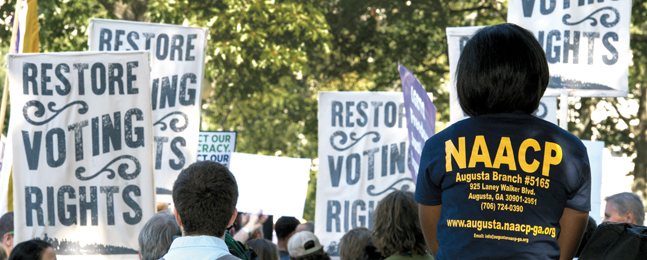Perspective
A Bad Solution to a Nonexistent Problem
Republican-led efforts to limit voting access could weaken election turnout and, ultimately, democracy.

Paul J. Richards / AFP via Getty Images
by Zachary Albert
As we head into this fall’s midterm elections, restrictions around mail-in voting, early voting, same-day registration and voter ID requirements are, predictably, drawing a lot of attention.
According to the Brennan Center for Justice, during the first full year after the 2020 presidential election, 19 states passed laws restricting voting access — far more than any other year since 2011. All but one U.S. state saw restrictive measures introduced in their legislature. Most of the restrictive laws were enacted in Southern, Republican-leaning or battleground states like Texas, Arizona, Georgia and Florida.
During the same period, roughly 30 states considered or passed bills expanding voting access. Most of the successful bills were introduced in Democratic-controlled state legislatures in the North and the West.
At the national level, two bills passed by Democrats in the House of Representatives, the John R. Lewis Voting Rights Advancement Act and the For the People Act — which would beef up federal oversight of voting regulations, institute same-day registration and establish nationwide early voting — are unlikely to pass the Senate without filibuster reform or a filibuster-proof Democratic majority.
All these reform attempts reflect the broad partisan polarization that has infected efforts to regulate voting. There are certainly genuine (if sometimes misplaced) concerns on either side, with conservatives mostly focused on improving election integrity and liberals mostly focused on voting equality. And partisan elites have their own strategic motivations: Republicans may benefit at the ballot box from certain voting restrictions, especially those that disproportionately target Democratic voters, while Democratic elites are rightly and self-interestedly focused on making it easier for their base to participate.
But there is one important difference separating the two coalitions. Former President Donald Trump and his allies talk frequently of a “fraudulent” 2020 election. This claim, while patently false, has refocused attention on issues like voting by undocumented immigrants and repeat voting — allegations that have little to no empirical support but have long animated the most ardent Republicans. According to an April 2021 NBC News poll, 77% of Republicans said it was more important to make sure that no ineligible person votes than to ensure that all eligible voters who want to participate can cast a ballot. Only 10% of Democrats agreed with that statement.
In fact, there is no evidence that voter fraud occurs beyond a small number of isolated instances. Though immigrants and others were encouraged to “vote early and often” in the late 19th century, such practices are essentially unheard-of in recent decades. Studies purporting to show high levels of undocumented voting — such as the one touted by candidate Trump in 2016 — have been thoroughly debunked on methodological grounds.
Instead of legions of citizens and noncitizens voting illegally, today’s problem is the opposite: Too few people who are eligible to vote actually do so. The turnout rate in recent decades has hovered around 60% for presidential elections and 40% for midterms. Nonconcurrent state-level elections have even lower rates. Voters who do participate tend to be more able (e.g., better educated, with a higher income) and motivated (e.g., strongly partisan or ideological). Efforts to further restrict the vote are likely to exacerbate these participatory distortions.
A cost-benefit framework of voter participation is a useful (if imperfect) mindset for better understanding these effects. It may not seem that the costs of certain voting restrictions — obtaining a valid ID, turning out on a specific weekday, traveling to a specific polling place — are particularly high. But neither are the benefits of voting, especially for the less motivated.
Potential voters know the probability of their vote deciding an election is effectively zero. Unless they get some added value from turning out — a sense of fulfilling a civic duty, for instance, or admiration from their peers — they are quite unlikely to do so. Any marginal increase in the difficulty of voting will turn away a greater number of moderate independent voters and others who lack the motivation to participate.
The costs of common voting restrictions are disproportionately borne by the already marginalized. Countless studies have found that voter ID laws, restrictions on mail-in voting and other efforts that increase the costs of participation widen already large racial and socioeconomic turnout gaps, with black, Hispanic and low-income voters most likely to be turned away or otherwise discouraged from voting.
It’s clear most proposed voter restrictions are a solution to a problem that does not exist, except in rare instances. These solutions, meanwhile, bring with them marginal costs that have major implications for democratic representation.
Republicans with a vested interest in further restrictions are likely to sweep away such conclusions. But they might be wise to consider the unintended strategic consequences of their efforts.
As Republican candidates use allegations of fraud to mobilize their base, there are real concerns (even among Republican insiders) that narratives centered on stolen elections lead Republican voters to abstain from participating in what they see as a rigged system. Furthermore, there is strong evidence that certain reforms — such as same-day registration and mail-in voting — would benefit both parties equally.
In the short term, voter-restriction laws may disadvantage the Republican Party just as much as or more than the Democrats.
In the long term, the health of American democracy is at risk.
Zachary Albert is an assistant professor of politics.
